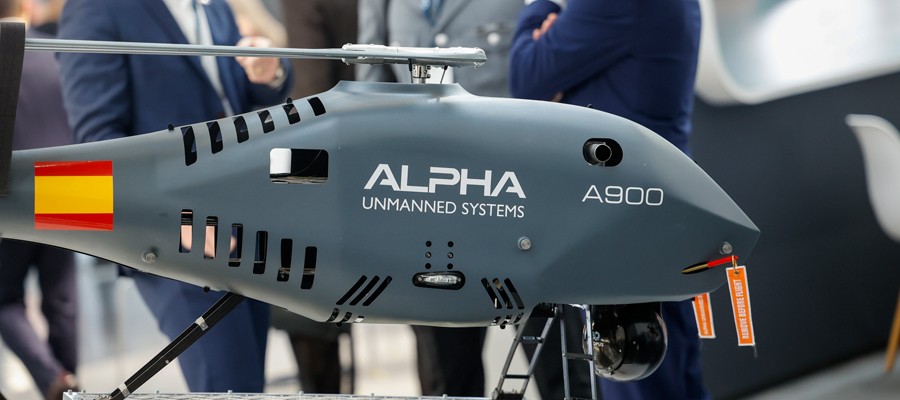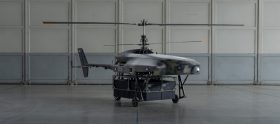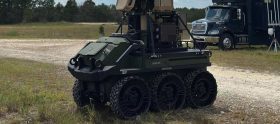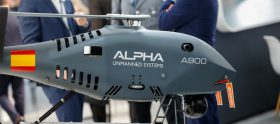Race to catch up in the skies: drone defense and critical infrastructure protection are the focus at XPONENTIAL Europe
Airspace violations, hostile drone flights, disruptive maneuvers at airports at home and abroad: the new reality of security and defense policy has caught up with Europe. This is also evident at XPONENTIAL Europe in Düsseldorf. The trade fair for autonomous systems and robotics is dominated by dual use – the civil and military application of technologies. In the defense sector, the focus is on autonomous systems deployed for defense purposes – for example, in aerial reconnaissance, defense against attacks, logistics support or control of units in action.


“The creation of a Europe-wide drone wall is a central theme of the upcoming XPONENTIAL Europe,” says Trade Fair Director Malte Seifert. In view of the current threat situation, experts are calling for the establishment of a national task force for detection and air defense. Against this backdrop, Seifert says, XPONENTIAL Europe, as a trade fair for technology leaders, is the most important platform for the industry in Europe. It is clear that, alongside large defense companies, start-ups are also shaping the landscape. Many of them will be exhibiting at XPONENTIAL Europe, which will take place from 24 to 26 March 2026 at the Düsseldorf Exhibition Centre.
Sometimes the future begins in places that can only be found with GPS. For example, in Schrobenhausen, Gilching or the small community of Strickscheid. What connects these places is the fight against hostile drones. This applies to Quantum Systems in Gilching, MBDA Deutschland in Schrobenhausen and Aaronia AG in Strickscheid. This idyllic spot in the Vulkaneifel has a total of 28 inhabitants. Most visitors who come here are not searching for castles, volcanic landscapes or the Nürburgring, which is 60 kilometres away. Instead, their destination is Aaronia AG. Back in 2013, this company, which specialises in measurement, localisation and surveillance technology, developed the world’s first drone detection system, AARTOS. More than 600 of these systems are currently in operation worldwide. Wherever they are deployed, they protect airports, power stations, NATO territories and conferences – for example, London Heathrow, Singapore and Oman airports, and the NATO summit in The Hague.
Drone Wall: Europe’s defense is regrouping
They are just one element in the growing effort to counter the growing threat, which has become increasingly serious. In the first quarter of this year alone, there were more than 500 suspicious drone sightings in German airspace. Against this backdrop, the EU has substantiated the much-discussed initiative for a drone wall. The aim is to create a multi-layered defense system against unmanned threats. Similar to the European Sky Shield Initiative (ESSI) for ground-based air defense, this is to be set up as a pan-European programme. The aim is to network existing national capabilities, integrate stationary and mobile systems, and significantly increase the number of C-UAS solutions – in detection, identification and targeted defense in air defense and ground-based air defense.
The threat situation is dynamic
“The current (hybrid) threat posed by drones is dynamic and highly complex. The key thing is that we have systems and solutions that are ready for immediate deployment – at the same time, we are working flat out to scale them up and continuously develop them in line with specific threat scenarios,” says Daniela Hildenbrand. She is an expert in drone defense at sensor specialist and system integrator HENSOLDT. The Taufkirchen-based company was established eight years ago through the spin-off of Airbus Defense and Space’s former sensor technology business units in the fields of defense, security, aerospace and aviation. Today, HENSOLDT is one of Europe’s leading providers of defense and security electronics. Its radar and optronic systems are used by the German Armed Forces and police, as well as by the armies and security agencies of allied nations. A strategic partnership was concluded this spring with Quantum Systems, one of the leading manufacturers of reconnaissance drones. The aim of this collaboration is to advance the development of software-defined defense systems. The partnership combines HENSOLDT’s extensive expertise in sensor data fusion, sensor resource and data management, and distributed systems with Quantum Systems’ state-of-the-art unmanned aerial systems and software stack.
Interceptor drones to protect airspace
Just a few weeks ago, Quantum Systems presented the “Jäger” drone, an interceptor drone with rocket propulsion and autonomous AI control. It is powered by a solid-fuel rocket engine and can be catapulted to an altitude of 4,000 metres in just 30 seconds. The system is designed to neutralise enemy drones. Thanks to its interference-resistant data link and autonomous control without GPS dependency, the system remains functional even in electronically disrupted environments.
Start-ups strengthen defense capabilities
Quantum Systems’ hunters are just one of the weapon systems being deployed. Start-ups such as Argus Interception from Rotenburg an der Wümme in Lower Saxony, whose aircraft are equipped with capture nets, and the Munich-based company Tytan Technologies are also involved in providing defense. Just a few weeks ago, the company founded in 2023 on the banks of the Isar, was commissioned by the German Armed Forces to develop a concept for the protection of all military properties under its command.
Cooperation between defense companies
The giants of the defense industry are also set to secure the airspace. Just a few weeks ago, Rheinmetall signed contracts to supply the Skyranger air defense system to Ukraine and the German Armed Forces, with orders also coming in from Denmark and Austria. Rheinmetall, the largest exhibitor at XPONENTIAL Europe, announced its collaboration with Taurus manufacturer MBDA Germany last year. The aim is to integrate a small anti-drone missile from MBDA into the Skyranger 30 and other military vehicles from Rheinmetall. This will enable small and medium-sized drones in particular to be neutralised in future.
XPONENTIAL Europe showcases multilateral technology
There is considerable pressure to create an interoperable, networked defense system as quickly as possible that bundles and manages data from radar, optical sensors and drone defense systems. However, the issue is complex – technically, legally and organisationally. Questions persist, such as the distribution of responsibilities between the armed forces and the police, as well as integration into existing NATO and EU structures. “Against this backdrop, the technological platforms on display at XPONENTIAL Europe are multilateral,” says Malte Seifert. Defense will feature prominently at the trade fair, which will take place for the second time in March 2026. The successful premiere saw 189 companies from 33 nations present their products, including Rheinmetall, Quantum Systems, BAE Systems from the UK and Airbus.
Aviation associations call for national task force
Meanwhile, the German Aerospace Industries Association (BDLI) and UAV DACH – Association for Unmanned Aviation have issued a joint paper calling for the formation of a national task force. According to Dr Gerald Wissel, CEO of UAV DACH, this is the only way to establish clear responsibilities. In his opinion, Germany is currently not in a position to respond efficiently and effectively at all times to illegally used drones and the potential threat they pose:
“We urgently need a national task force led by the Federal Ministry of the Interior to coordinate the necessary measures in the area of drone detection and defense at federal and state level. This is the only way to prevent unilateral action and a patchwork of measures and to ensure a coordinated approach across Europe.”
The work of such a task force could be based on the recommendations for action developed by experts from the two professional associations in the joint working group “Drone Detection & Countermeasures”. A central element of this is the mandatory, tamper-proof electronic visibility of all participants in lower airspace. “UAV DACH is therefore advocating a standardised and binding European procedure for electronic visibility via ADS-L,” explains Dr Gerald Wissel.
While Wissel calls for political will, Seifert points to the technology that can be seen at XPONENTIAL Europe: “The exhibitors at XPONENTIAL Europe provide the necessary technology.”
About XPONENTIAL Europe 2026
XPONENTIAL Europe is the new leading trade fair for unmanned systems and robotics in all areas of autonomous technology. Following its successful premiere in 2025, it will once again bring together experts and executives from around the world in Düsseldorf from 24 to 26 March 2026 – from developers to decision-makers from industry, research and politics. With its combination of an international trade exhibition, a high-calibre conference programme, practical demonstrations and targeted networking, XPONENTIAL Europe is the leading platform for the future of autonomy – and a unique meeting place for visions, applications and the previously fragmented international industry.
All information on the event’s focal points and programme highlights is available on the portal: www.xponential-europe.com
Im Drones PR-Portal erscheinen Nachrichten und Meldungen von Unternehmen aus der Drone-Economy. Für die Inhalte der Pressemitteilungen sind die jeweiligen Unternehmen verantwortlich.







